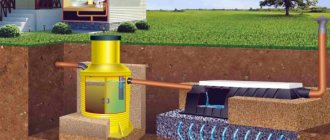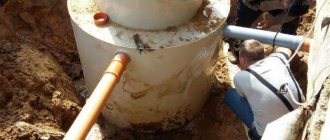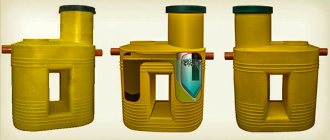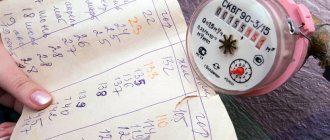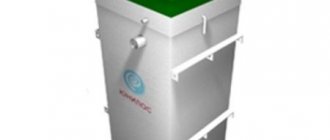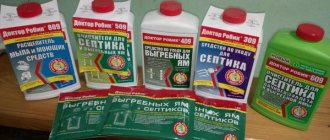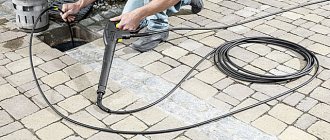Septic tank Uponor Bio is a universal biochemical unit for batch wastewater treatment, suitable for various plots of land intended for residential construction.
The Onor septic tank effectively processes all wastewater that is generated in a residential building (toilet, kitchen, shower, bath). Uponor Bio septic tanks provide combined treatment (chemical and biological) and do not require the connection of additional post-treatment and wastewater filtration systems.
Design and principle of operation of an Uponor septic tank
The design of an Uponor septic tank directly depends on its functional properties. But the common feature is the material – high-strength and frost-resistant plastic. Also in the Uponor septic tank there are anchors, which are presented in the form of weights fastened in pairs with a cable. Fixation of the device is ensured by the mass of earth, which prevents the plates from moving. During installation, they are thrown over containers and secured in special grooves. This approach of the manufacturer ensures that the septic tank remains reliably in one position, even if groundwater rises.
Uponor Sako septic tank equipment
These are non-volatile devices, which allows you to save on energy consumption. Uponor Sako septic tanks have a standard configuration - one or more tanks that are connected into a system via overflow pipes. The latter elements are easily detached, making it possible to replace them in case of any damage. The body of Uponor Sako septic tanks is made of frost-resistant plastic, so the system can be installed even in winter. The tank necks are removable, making transporting the system much more convenient.
The package also includes a distribution well, which promotes uniform distribution of wastewater. The design of the filtration field consists of perforated pipes (1-6), which are mounted in a bed of gravel and sand. This creates drainage, which allows for another cleaning step. The well allows you to evenly distribute the flow of drainage water and control the quality of its purification. It has a flow regulator that controls the pressure force. The Uponor Sako septic tank kit also includes plugs, top manhole covers and filtration material.
Wastewater treatment in Uponor Sako septic tanks is carried out in several stages:
- the waste mass enters the sewer pipe, which is connected to the septic tank - in the first tank the process of sedimentation of large fractions takes place;
- then the liquid with small inclusions flows into the second tank, where it settles;
- some Uponor Sako septic tank models include a third tank, which serves as another sump for wastewater;
- then the purified water goes into the distribution well, where it flows into perforated pipes;
- at the last stage, the liquid enters the backfill, through which it reaches the ground.
Maintenance of Uponor Sako septic tanks requires the help of sewer trucks, as a lot of sludge collects in the settling tanks. BUT! Such tanks are not completely cleaned, since the process of natural decomposition produces bacteria that can be removed. Therefore, when cleaning sedimentation tanks, you need to leave a little liquid.
If necessary, you can install an additional filtration element - an infiltrator - to the Uponor Sako septic tank. This is an underground post-treatment system. But it is rational in cases where on the site the difference between the highest point of groundwater and the bottom of the septic tank is no more than 1 m. But such an addition will increase the price of the septic tank.
Uponor Bio septic tank equipment
Unlike the Sako model range, here the manufacturer has slightly reduced the dimensions of the system. Just like the previous analogue, Uponor Bio septic tanks are energy independent. These septic tanks use a triple treatment system. The Finnish manufacturer also included chemicals in the process that break down any contaminants.
Uponor Bio septic tanks have 15 liter tanks designed for bacterial compounds and chemical reagents. These containers are equipped with a special portioned liquid supply system, which reduces the load on the entire system. Wastewater treatment in Uponor Bio septic tanks occurs as follows:
- In the first tank, primary sedimentation of the liquid occurs until silt sediment occurs. At this stage, the water is purified from large fractions, after which the wastewater is transferred to the next container.
- At the second stage, precipitation occurs again, and the upper layer of wastewater passes into the third compartment. Technological cleaning takes place in the second tank. There is a fill regulator that turns on the air supply as soon as the liquid reaches its limit. The compressor releases gas, which breaks the remaining fractions into smaller components.
- The third container is filled with chemical reagents, which are supplied in doses. The calculation is carried out electronically. Additives have a neutralizing effect on harmful chemical compounds, while simultaneously disinfecting wastewater. An airlift is located in this compartment, which pumps out sludge. There is a pipe at the top of the tank through which clean liquid flows into the drainage ditch.
If necessary, Uponor Bio septic tanks can be supplemented with a special preparation with anaerobic bacteria. They help improve the quality of wastewater treatment and prevent the formation of plaque on the walls of tanks.
Septic tank Uponor Bio ↑
The Uponor Bio design is a more technologically advanced and versatile station with a high degree of filtration.
Photo: septic tank uponor bio
It is designed for complete treatment of domestic wastewater. Its main advantage is complete autonomy of operation.
Important! An important factor is the compactness of the installation - unlike Sako models, it does not require special filter fields.
Advantages:
- 3-stage filtration;
- autostart system with preservation of initial parameters during a power outage;
- wireless control and alarm system;
- the septic tank works successfully with almost all types of domestic wastewater;
- a unique function is provided to maintain the vital activity of bacteria for up to 3 months without operating the device.
Disadvantages that are common to all devices with bio-cleaning functions:
- For the Onor Bio septic tank to operate, an electrical connection is required;
- Once every 2-3 years, the septic tank device needs to remove the accumulated sludge.
The uniqueness of this cleaning device lies in the principle of its operation, which directly depends on the design features.
Principle of operation
A high degree of purification of Uponor Boi wastewater is possible due to 3-stage filtration. To implement this mechanism, the entire structure is divided into certain zones.
Sedimentation reservoir
Photo: sedimentation tank
This is the first container into which water enters. At this stage, precipitation of heavy elements occurs. And this happens in 2 stages. Subsequently, the liquid goes through the next stage of purification.
Process tank
Photo: process tank
When the liquid reaches the start level, the compressor unit starts. It enriches the water with oxygen, as a result of which solid fractions disintegrate. Aeration is also necessary to create an optimal environment for the next cleaning step.
Adding a Chemical
Photo: adding a chemical
Its container is located at the top of the neck. As needed, the chemical is dosed into the main volume. It serves to neutralize most of the phosphorus.
Moving sludge residue
Photo: moving sludge residue
This process is very important. When the process tank is filled with sludge to a certain point, it stops. Excess sludge is transferred to the filling tank using the airlift principle.
This promotes a better primary cleaning process and at the same time creates an optimal environment for microorganisms in the process vessel.
Water disposal
At the end of the full filtration cycle, all purified liquid is removed by gravity from the process tank. In this case, it is necessary to maintain the required slope of the pipe and first take care to prevent it from flowing back into the tank.
It is thanks to this technological scheme that a high degree of wastewater purification is achieved.
Modifications
Unlike Sako Uponor Bio models, it has more productive characteristics.
BioClean 5
Photo: BioClean 5
Photo: BioClean 5 diagram
Compact and reliable model, designed for 5 people. Structurally, it consists of 2 working tanks located in one building.
Characteristics:
- maximum productivity – 1.1 m³/day;
- Salvo discharge – 500 l;
- The optimal chemical consumption is 45 l/year.
Video: Installation of Uponor BioClean5
Bio 10
Photo: Bio 10 septic tank
The high productivity of this model is due to the increased volume of the tanks. This septic tank can be connected to the sewerage system of a residential building with 10 residents.
In addition, the standard delivery package includes connecting pipes between tanks and a remote control panel.
Characteristics:
- maximum productivity – 1.5 m³/day;
- salvo discharge - 1100 l;
- The optimal chemical consumption is 90 l/year.
Bio 15
Photo: septic tank Bio 15
This has the highest productivity and can serve up to 15 people. It is often used as a general cleaning system for several private homes.
Characteristics:
- maximum productivity – 2.2 m³/day;
- salvo discharge - 1650 l;
- The optimal chemical consumption is 90 l/year.
Installation Tips
To carry out installation work, it is necessary to first prepare the pit. It must be located at least 5 m from a residential building. To ensure waterproofing and stability, its bottom is sprinkled with sand and crushed stone.
Important! An anchoring system is used as a safety measure against floating.
Installation is carried out in such a way that all inlet and outlet pipes are located below the freezing level.
If this is not possible due to the small height of the neck, then it can be lengthened using a special corrugated pipe. The standard pit depth is 165 cm.
Photo: insulation gasket
If weather conditions may favor internal icing, then insulation should be installed before laying the top layer of soil.
The control unit is installed in close proximity to the process tank.
Its second part (remote control) can be installed in any part of the house. Restrictions on the maximum distance between control elements are given in the passport.
Service
After final installation, it is necessary to fill the entire system 2/3 with water through the neck of the filling tank. After this, you can begin the operation process.
Maintenance consists of checking the operation of all elements of the septic tank. It is carried out by employees of the service company. They also indicate the time for pumping out excess sludge.
You can fill the process tank with chemicals yourself. In this case, personal protective measures must be observed - rubber gloves, safety glasses.
The technology for welding HDPE pipes is discussed in the article: welding HDPE pipes. How to install a bathtub on bricks can be seen in the video.
The process of connecting a washing machine to the sewer with your own hands is described here.
The lineup
The Finnish manufacturer of septic tanks Uponor has developed several lines of devices, each of which has its own gradation of models. Depending on the needs of the site, it is necessary to pay attention to the technical characteristics of the septic tank, because the price depends on this.
When choosing a septic tank, you must remember the following nuances:
- wastewater flow – Uponor septic tanks have models with a capacity of 500 to 2200 liters per day;
- type of soil of the site - purified water is discharged into the ground, which should be able to absorb the entire volume;
- relief of the site;
- climatic conditions - temperature regime of the zone and level of ground freezing;
- the ability to order sewerage services - the septic tank requires cleaning once a year;
- if the model implies the presence of a filtration field, then they need to be moved once every 5–15 years (depending on the intensity of use of the septic tank).
Also models with biological and chemical components that need to be controlled. Therefore, before purchasing a septic tank, you need to find out about the availability of such a service and its price.
The Finnish manufacturer presents a wide range for its customers:
- Uponor septic tank Sako series – wastewater requires final treatment in the soil;
- Uponor septic tank Bio series - due to the presence of biological and chemical components, complete wastewater treatment is carried out;
- Uponor septic tank BioClean series - premium models that are equipped with electronics.
Below are the most popular Uponor septic tank models:
- Sako 1.5. Capacity - 500 liters per day (up to 3 people), dimensions - 1200x1750x2100mm, weight - 121 kg, price - 88,000 rubles.
- Sako 2. Capacity - 600 liters per day (up to 6 people), dimensions - 2800x1200x1070mm, weight - 190 kg, price - 103,000 rubles.
- Sako 3. Capacity - 1000 liters per day (up to 8 people), number of chambers - 3, dimensions - 1200x3900x1750mm, weight - 300kg, price - 155,000 rubles.
- Sako 4. Capacity - 1300 liters per day (up to 10 people), number of chambers - 3, dimensions - 1200x5200x1750mm, weight - 400kg, price - 180,000 rubles.
- Uponor Bio 5. Capacity – 1100 liters per day (up to 5 people), critical volume – 170 liters, weight – 235 kg, price – 550,000 rubles.
- Uponor Bio 10. Capacity – 1500 liters per day (up to 10 people), critical volume – 300 liters, weight – 485 kg, price – 580,000 rubles.
- Uponor Bio 15. Capacity – 2200 liters per day (up to 15 people), critical volume – 350 liters, weight – 667 kg, price – 660,000 rubles.
- Uponor BioClean 5. Capacity – 1100 liters per day (up to 5 people), weight – 240 kg, price – 330,000 rubles.
All of the above prices are approximate, since the cost of a septic tank depends on many factors - the place of purchase, the dollar exchange rate, the seller’s shares, etc. But there is an opportunity to save money if you purchase one along with a septic tank.
Overview of the model line and its features
The Finnish manufacturer's product range includes three types of installations designed for local and effective wastewater treatment:
- Uponor Sako : this brand produces settling tanks that differ from each other in different volume sizes. When wastewater enters these containers, it settles, but is not completely cleared of impurities and suspended matter. Therefore, when installing these products, it is necessary to arrange filtration fields that provide soil post-treatment of domestic wastewater.
- Uponor Bio : in these local treatment plants, along with the technology of settling liquid waste, deep chemical and biological treatment methods are used.
- Uponor BioClean : high-quality and expensive premium products that differ from their “brothers” in the model range due to their compact size, convenient control of the cleaning process and the degree of waste clarification.
A feature of all products produced by the Finnish company is their one-piece cast construction, devoid of any seams. Sealed containers are molded from high-density polyethylene.
Sufficient wall thickness ensures unsurpassed strength of the treatment plant over a long service life. This is what distinguishes Finnish septic tank models from domestic products, the production of which uses the technology of combining several individual elements into a single container. The presence of seams affects the strength of the products.
Advantages of Uponor septic tanks
Before spending money on purchasing such equipment, it is worth conducting a comprehensive analysis of the septic tank. Consider all its strengths. Only in this case can you decide whether it is worth the price stated by the manufacturer.
Among the advantages of an Uponor septic tank are the following:
- Uponor Sako models are energy independent, which means you don’t have to spend money on electricity bills;
- overflow of wastewater by gravity ensures complete settling of any precipitation - this approach protects filtration fields from clogging;
- the Bio series carries out cleaning in portions, thereby increasing the quality of liquid filtration;
- Uponor Bio does not require a large installation area;
- There are no moving parts inside septic tanks, so even with mechanical impact, the risk of damaging anything is minimal.
- Sacco septic tanks purify wastewater by 85-90% of contaminants, Bio septic tanks by 92-97%.
Having familiarized yourself with all the advantages of Uponor septic tanks, you can decide for yourself not only the rationality of such a purchase, but also decide which model is more suitable in a particular case - Sacco or Bio.

